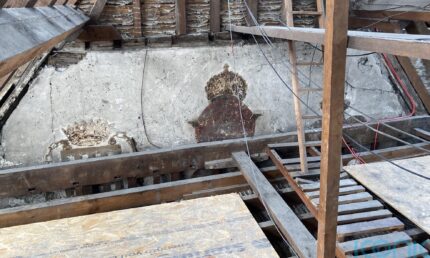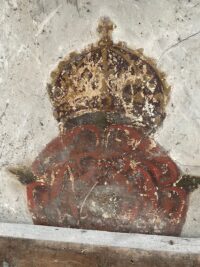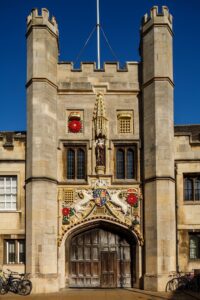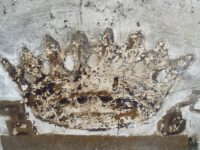 Builders restoring the roof of a 16th century building at Christ’s College, Cambridge University, have discovered three wall paintings hidden behind a wooden roof joist. The wall paintings depict a crowned portcullis, a crowned red Lancaster rose and a third motif that is partially obscured but is likely a fleur-de-lis. These motifs are all elements of the family crest of the foundress of Christ’s College, Lady Margaret Beaufort, mother of King Henry VII.
Builders restoring the roof of a 16th century building at Christ’s College, Cambridge University, have discovered three wall paintings hidden behind a wooden roof joist. The wall paintings depict a crowned portcullis, a crowned red Lancaster rose and a third motif that is partially obscured but is likely a fleur-de-lis. These motifs are all elements of the family crest of the foundress of Christ’s College, Lady Margaret Beaufort, mother of King Henry VII.
The paintings were found in First Court, the oldest part of Christ’s College dating to the 15th century, in the roof over the northwest wall of the original library. They extend over 20 feet and were painted directly onto the plaster. Limewash was applied around the artworks to make them stand out.
 Originally founded as God’s House, a school for grammar teachers, in 1437, it was enlarged and refounded as Christ’s College by Margaret Beaufort in 1505. She financed the transformation of a modest school into a fully-fledged college of Cambridge University, donated 39 books to form the kernel of its prestigious library, endowed it with two estates complete with their manors and spent £1625 on construction for the college between 1505 and 1509. She bequeathed even more of her properties to Christ’s College in her will, guaranteeing that it would have the steady income needed to thrive as an educational institution for centuries after her death.
Originally founded as God’s House, a school for grammar teachers, in 1437, it was enlarged and refounded as Christ’s College by Margaret Beaufort in 1505. She financed the transformation of a modest school into a fully-fledged college of Cambridge University, donated 39 books to form the kernel of its prestigious library, endowed it with two estates complete with their manors and spent £1625 on construction for the college between 1505 and 1509. She bequeathed even more of her properties to Christ’s College in her will, guaranteeing that it would have the steady income needed to thrive as an educational institution for centuries after her death.
 Lady Margaret’s legacy is embedded in the architecture of Christ’s College. The family coat of arms, the portcullis of the Beaufort family, the red rose, the badge adopted by Henry VII as the first Tudor king, the white Marguerite (daisy) that was Lady Margaret’s personal emblem and the family motto “Souvent me souvient” (“I often remember”) are found on walls, over doorways and in monumental format over The Great Gate, the entrance into Christ’s College that still boasts its original 1509 oak door.
Lady Margaret’s legacy is embedded in the architecture of Christ’s College. The family coat of arms, the portcullis of the Beaufort family, the red rose, the badge adopted by Henry VII as the first Tudor king, the white Marguerite (daisy) that was Lady Margaret’s personal emblem and the family motto “Souvent me souvient” (“I often remember”) are found on walls, over doorways and in monumental format over The Great Gate, the entrance into Christ’s College that still boasts its original 1509 oak door.
Cambridge University art historian Dr Christina Faraday said: “This is a really exciting and unusual discovery.” […]
Dr Faraday, who specialises in Tudor visual and material culture, said the works revealed “the ways that the college celebrated and advertised its royal patron during the early years of the 16th Century, following its re-founding”.
“A powerful and pious woman, with a keen interest in scholarship, Lady Margaret left her indelible mark on the college,” Dr Faraday said.
“The wall paintings are an early example of her family’s savvy use of visual ‘branding’ even beyond the royal court. Henry VII had a very weak claim to the throne, but became adept at using visual symbols like this to promote his kingship.”
 It’s rare for murals like these to survive centuries of refurbishments. They were inexpensive decorations to begin with so there was little incentive to go to the trouble of preserving them when changes were made to the buildings. Researchers checked the archives after the murals were rediscovered and the last eye-witness account of the wall paintings was recorded in around 1738.
It’s rare for murals like these to survive centuries of refurbishments. They were inexpensive decorations to begin with so there was little incentive to go to the trouble of preserving them when changes were made to the buildings. Researchers checked the archives after the murals were rediscovered and the last eye-witness account of the wall paintings was recorded in around 1738.
The paintings were preserved by benign neglect thanks to their covered location in the roof. That location also means they won’t go on display, unfortunately. They will, however, be restored and stabilized in situ.
Paul Hentzner’s, “Travels in England during the reign of Queen Elizabeth” –published in Latin in 1612AD as “Itinerarium Germaniae, Galliae, Angliae, Italiae, cum Indice Locorum, Rerum atque Verborum.”– notes for 1598AD:
—-
“…London, the head and metropolis of England (…) On the south is a bridge of stone eight hundred feet in length, of wonderful work (…) Upon this is built a tower, on whose top the heads of such as have been executed for high treason are placed on iron spikes: we counted above thirty. (…)
The church [in Westminster] is remarkable for the coronation and burial of the Kings of England. Upon this spot is said formerly to have stood a temple of Apollo, which was thrown down by an earthquake in the time of Antoninus Pius (…) Between the second and third choirs in the side-chapels, are the tombs of Sebert, King of the East Saxons, who built this church with stone and of …
Margaret of Richmond, mother of Henry VII., grandmother of Henry VIII.; she gave this monastery to the monks of Winbourne, who preached and taught grammar all England over, and appointed salaries to two professors of divinity, one at Oxford, another at Cambridge, where she founded two colleges to Christ and to John his disciple. She died A.D. 1463 [actually, in 1509], on the third of the calends of July.”
—-
vs. Wikipedia: “Erasmus wrote the Latin inscription on her tomb. In English it reads:
Margaret, Countess of Richmond, mother of Henry VII, grandmother of Henry VIII, who donated funds for three monks of this abbey, a grammar school in Wimborne, a preacher in the whole of England, two lecturers in Scripture, one at Oxford, the other at Cambridge, where she also founded two colleges, one dedicated to Christ, and the other to St John, the Evangelist.”
—-
PS: Paul’s book reads in Latin:
[Anno 1598] …”Margarethae Ritschmundiae Septimi Henrici matri, Octavi avii, quae stipendia constituit, tribuit hoc Coenobium Monachis, & Doctoribus Grammatices, apud Werbrun, perq; AngIiam totam, divini verbi praeconibus, duobus item interpretibus literarum sacrarum, alteri Oxoniis, alteri Cantabrigiae, ubi & Collegia duo, Christo & Ioanni discipulo eius struxit, Moritur anno Domini M.CCCC.LX. ///. Cal. Julii.”
…No idea, what went wrong.
Since these were painted in an area never to be seen by many people, maybe they were “ practice” designs by an amateur?
Hello. I enjoy your site very much and I give my self a treat each day of a visit, because it always makes me feel better! I appreciate what you do, and how well you do it.
I now have a question, and that is I have what I’m pretty sure is some type of neolithic hand axe, which I found when I was a kid in Sardinia. It was on the surface of a ploughed olive grove. How do I set about getting it identified, please? I now live in Boston in the USA. I’m not sure who to contact. And idea would be most welcome. Very best wishes, Allan
Thank you so much for your wonderful work.
Each visit informs and launches a search for the some meaning of a baffling word or phrase never encountered.
Keep up the good work.